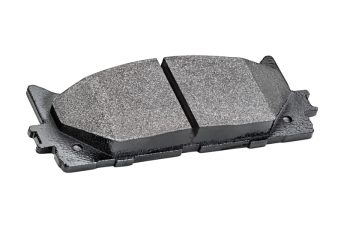Understanding Brake Pads
Auto /
August 23, 2024
What Are Brake Pads?
Brake pads are a crucial component of your vehicle’s braking system. They are designed to apply pressure and friction to the brake rotors, causing the vehicle to slow down or stop. Typically made of various materials, such as ceramic, metallic, or organic compounds, brake pads work by converting kinetic energy into heat energy, which is then dissipated.
Types of Brake Pads
- Ceramic Brake Pads
- Characteristics: Made from ceramic fibers, nonferrous filler materials, bonding agents, and minute amounts of metal. They are known for their durability, quiet operation, and lower dust production.
- Advantages and Disadvantages: While they offer excellent performance and are gentle on rotors, ceramic brake pads are generally more expensive than other types.
- Metallic Brake Pads
- Characteristics: Comprised of sintered iron, copper, steel, or other composite alloys, metallic brake pads are known for their high performance and durability.
- Advantages and Disadvantages: They offer strong stopping power but can be noisier and produce more brake dust. They also tend to wear down rotors faster than ceramic or organic pads.
- Organic Brake Pads
- Characteristics: Made from a combination of natural materials such as glass, rubber, carbon, and Kevlar, these pads are the most environmentally friendly option.
- Advantages and Disadvantages: Organic pads are quieter and more affordable but generally have a shorter lifespan and are less effective under extreme conditions compared to ceramic or metallic pads.
Factors Affecting Brake Pad Lifespan
Driving Habits
- Aggressive Driving: Frequent hard braking, high-speed driving, and quick acceleration can lead to a shorter brake pad lifespan. This type of driving style increases the amount of heat and friction the pads endure, leading to faster wear.
- City vs. Highway Driving: Urban driving typically involves more stop-and-go traffic, leading to more frequent use of brakes and thus quicker pad wear. In contrast, highway driving usually requires less braking, which can extend the lifespan of the pads.
Vehicle Type and Weight
- Heavy Vehicles: Vehicles like trucks and SUVs generally have more weight, which puts extra strain on the brake system. As a result, the brake pads in heavier vehicles tend to wear out faster.
- Performance Vehicles: Sports cars and other high-performance vehicles are often equipped with more aggressive braking systems. While these systems offer enhanced stopping power, they can also lead to quicker brake pad wear.
Environmental Factors
- Climate and Weather Conditions: Driving in extreme temperatures, whether hot or cold, can affect brake pad wear. Heat increases friction, leading to faster wear, while cold weather can make the material more brittle and prone to cracking.
- Road Conditions: Driving on hilly terrain or in mountainous areas requires more frequent braking, which can shorten brake pad life. Additionally, driving on dusty or dirty roads can lead to contaminants getting between the pad and rotor, causing increased wear.
Brake Pad Material
- Ceramic Pads: As mentioned earlier, ceramic pads tend to last longer and are more resistant to wear. However, they are more expensive.
- Metallic Pads: These pads offer high performance but tend to wear down faster, especially in high-temperature environments.
- Organic Pads: Organic pads have the shortest lifespan among the three types but are often chosen for their low cost and environmental friendliness.
How to Extend Brake Pad Lifespan
Regular Maintenance
- Routine Inspections: Regularly inspecting your brake pads for wear can help you catch potential issues early. Look for signs like thinning pads, cracks, or uneven wear, and replace them as needed.
- Brake Fluid Maintenance: Ensure that your brake fluid is at the correct level and is clean. Contaminated or low brake fluid can lead to reduced braking efficiency, putting extra strain on the brake pads.
Proper Driving Techniques
- Smooth Braking: Gradually applying the brakes instead of slamming them can significantly extend the life of your brake pads. Smooth braking reduces the amount of heat and friction generated, leading to slower wear.
- Avoid Riding the Brakes: Constantly keeping your foot on the brake pedal, especially during downhill driving, can cause the brake pads to overheat and wear out faster. Instead, try to coast when possible and use engine braking to slow down.
Upgrading Brake Pads
- Choosing the Right Material: If you frequently drive in extreme conditions or have a performance vehicle, consider upgrading to a more durable brake pad material. Ceramic pads, for example, may be more suitable for high-performance applications.
- High-Performance Brake Systems: In some cases, upgrading your entire braking system, including the pads, rotors, and calipers, can provide better performance and longer lifespan.
Signs That Your Brake Pads Need Replacement
Squeaking or Squealing Noise
- Indicator Sound: Most brake pads have a built-in wear indicator that produces a high-pitched squeal when the pads are worn down. This is a clear sign that your brake pads
